Acer Aspire V5-171 Notebook Review: The Death and Rebirth of the Netbook
by Dustin Sklavos on November 21, 2012 3:01 PM EST- Posted in
- Laptops
- Acer
- Ivy Bridge
- Aspire V5
- Ultraportable
- Notebooks
Application and Futuremark Performance
When we talk about the performance of the Acer Aspire V5-171, it's the part that I think really matters the most. Vendors weren't really doing with Sandy Bridge (outside of the Sandy Bridge i3) what they're doing with Ivy Bridge now. This is essentially the top end of the netbook form factor; HP's dm1 was available with an i3 or Brazos (only Brazos currently), Lenovo's ThinkPad X100e line has the same thing going on. 11.6" notebooks mean either Brazos or an i3, and even there an i3 is generally going to be superior.
With the V5-171, though, we get an Ivy Bridge i5 that's able to turbo up substantially as well as beefier HD 4000 graphics. While on paper the E2-1800's IGP may be preferable, with superior driver support, the Ivy Bridge CPU cores will make up the deficit in a big way.
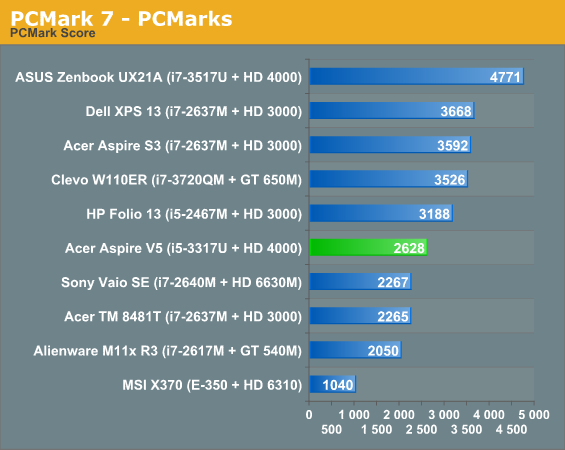
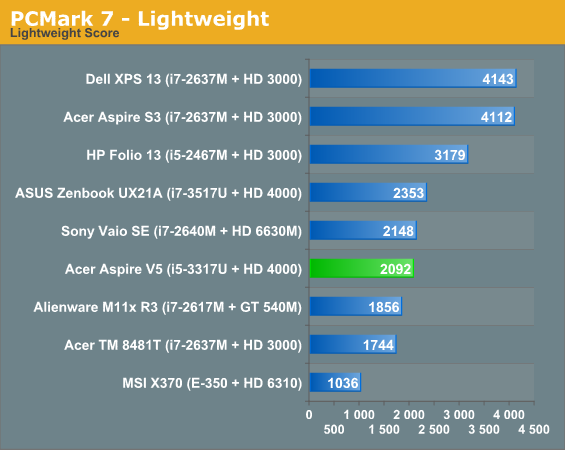
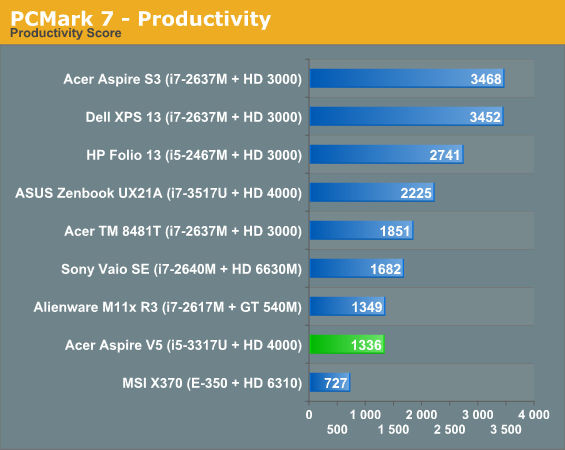
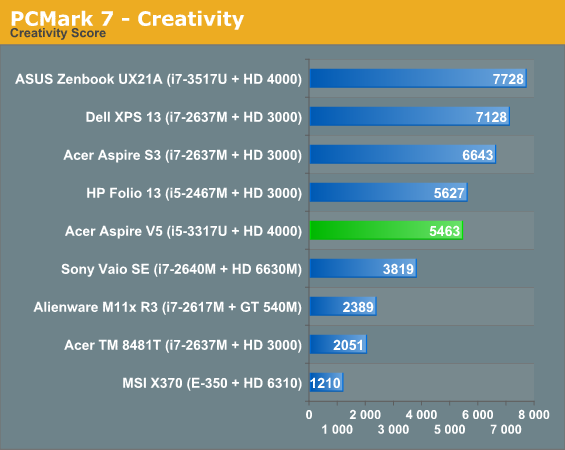

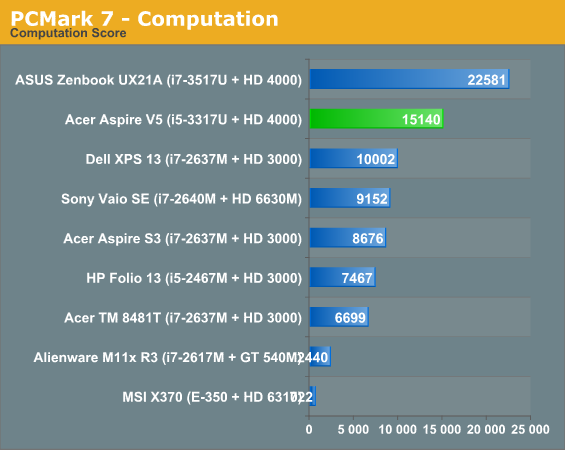
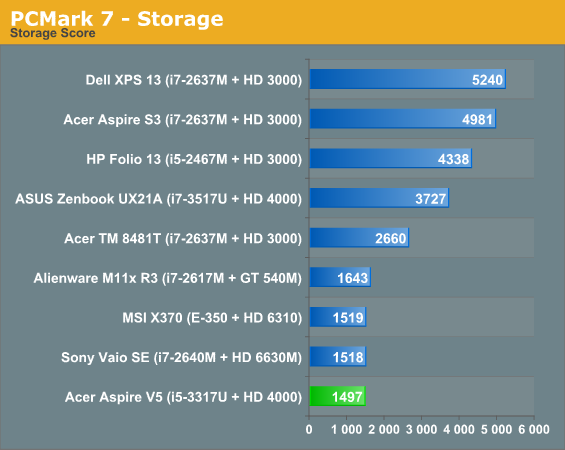
PCMark punishes the V5-171 for not including an SSD, but SSD prices have come down tremendously and you can always upgrade to one later (as I did). Last I checked, Amazon was selling Samsung's venerable 830 at a 128GB capacity for $80.
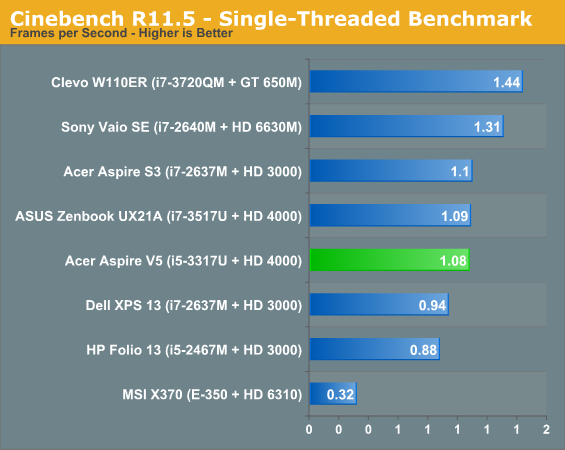
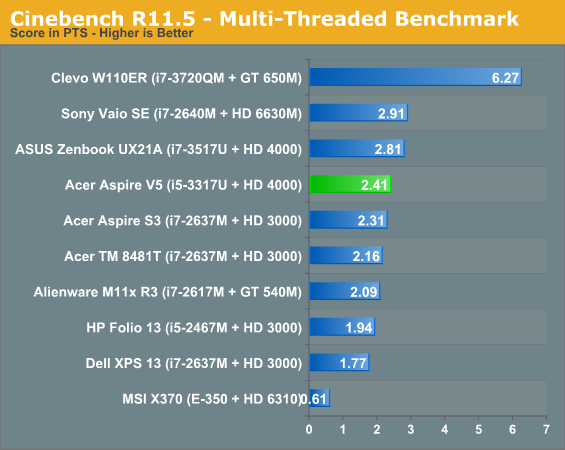
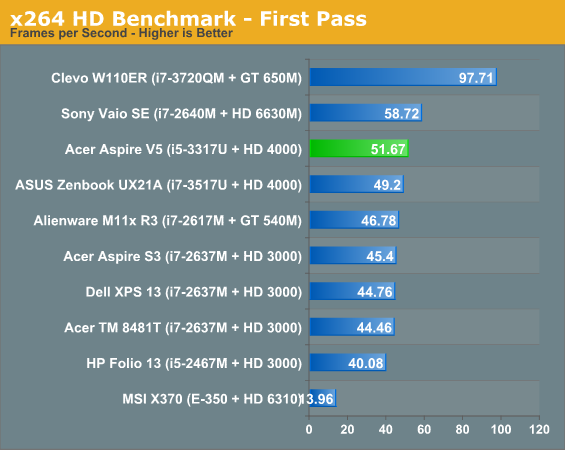
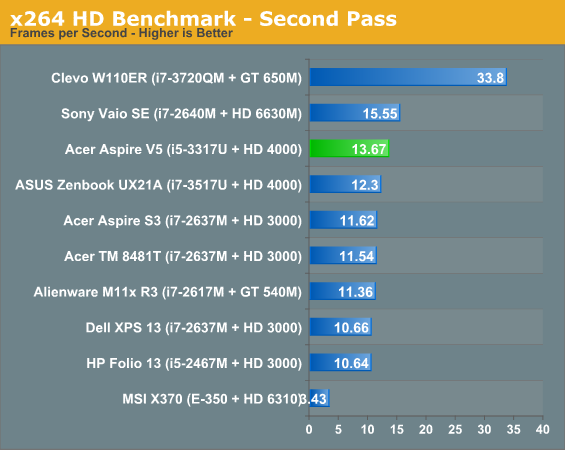
The CPU-specific benchmarks highlight both the performance gulf between Brazos notebooks and the tremendous amount of performance Intel was able to cram into a 17-watt power envelope. Note that the current generation E2-1800 is an incremental improvement on the E-350 we have listed, with a top CPU speed just 100MHz higher and no architectural changes. The i5-3317U isn't the fastest CPU, but it's remarkably powerful and mostly as fast as or faster than last generation's ULV i7s.
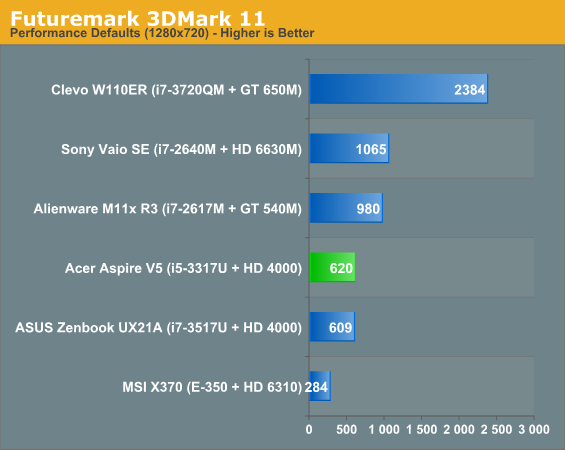

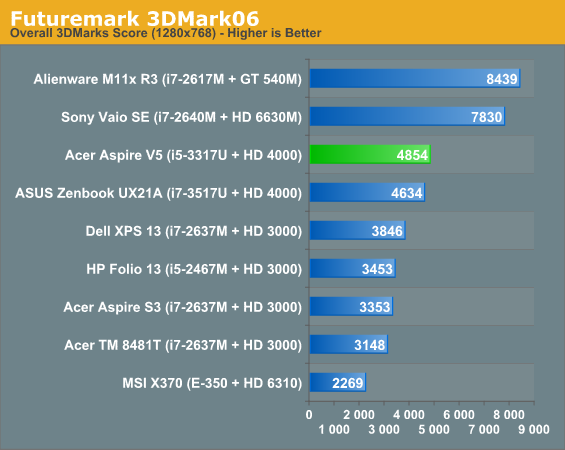
GPU performance isn't groundbreaking by a longshot, but it's a heady improvement on the HD 3000 and soundly ahead of Brazos. In anecdotal use, I found that the difference between the HD 3000 and 4000 in ULV chips was actually enough to make certain games (like Duels of the Planeswalkers 2013) much more playable. The HD 4000 in the V5 is also capable of running Guild Wars 2 at minimum settings and should have no trouble with World of Warcraft.
I remember when integrated graphics were, no matter how powerful the core was (AMD 780G, looking at you), pretty badly handicapped by memory bandwidth. Shared memory wasn't really the issue, it was the low speed of system memory preventing even 1280x800 or 1366x768 from being very playable. Fast DDR3 and efficient memory controllers have largely alleviated that bottleneck, though. I would never recommend the HD 4000 for a gamer, but I've found it's actually passable for casual use and is definitely enough to drive the V5's display.










32 Comments
View All Comments
DanNeely - Wednesday, November 21, 2012 - link
The one thing they've all lacked vs my EEE 1005 (premium netbook) is battery life. When it was new I could get 10-13 hours of light use on it, while every non-atom option I've looked at has been done by someone who decided the 5-7 hours of the stock netbook is good enough; draining the 6hr battery on my first netbook semi-regularly was the main reason I paid extra for the 1005 so I rather strongly disagree with that premise.Some of the clovertrail tablet-dock combinations announced recently at least offer similar to better battery life and with the user of narrow bezels some have even matched the physical size too; but I've yet to see anything with a faster CPU able to do the same.
joe30987rr - Saturday, November 24, 2012 - link
LOL ! the competitor to this notebook isnt an e-350, its a Llano, or better yet Trinity, both of which blow this laptop out of the water for graphics and multithreaded performance. Couldn't find any for the review ? What an unbelievable sham this site is. Why don't u guys just join the Intel marketing dept.Novaguy - Saturday, December 1, 2012 - link
Yeah, but there just aren't that many low power llano's or trinity's on the market. You would think that new low power 19W trinity (the a8-4555m quad core,which even comes with the full graphics portion, just underclocked to hit the tdp, I think) would be a great option in this market, but you just don't see them in wild that often. You just keep seeing the trinity chips in the 14 to 17.3 inch market.ltcommanderdata - Wednesday, November 21, 2012 - link
What did they do to the battery life on that thing? I had an 11.6" Acer 1810T, which is a predecessor to the notebook being reviewed. I got it when notebooks in this form factor were called ultraportables instead of ultrabooks and this was before the 11.6" MacBook Air was released. I liked it over the common netbooks of the time because it offered much of the portability of netbooks while having a decent CPU (1.4GHz dual core Penryn Core 2 Duo), a GPU with hardware h.264 acceleration (GMA 4500MHD), while offering just enough battery life to make it through a day of light use ~7 hr. Plus it was only $500 CND. The Acer Aspire V5-171 having only ~4 hrs battery life just doesn't have the same usefulness even if the specs and price are right.MadMan007 - Wednesday, November 21, 2012 - link
It's got a pretty small battery - look at the Wh ratings in the battery life charts. Having said that, are there extended batteries available? If so that would fix the most glaring issue that can be fixed with this notebook.DanNeely - Wednesday, November 21, 2012 - link
The 1810T is listed as having a "62W" (presumably they mean 62 Wh) battery; that's 67% more capacity. Unfortunately Acer chased smaller rather than longer lasting in the current model.liem107 - Wednesday, November 21, 2012 - link
Yep i had the 1810tz but it had a 6cell battery and it was about 200 g heavier i think.creed3020 - Friday, November 23, 2012 - link
We have the 1810 with Intel Core 2 Solo CPU. For it's age it runs Windows 7 with ease with the stock 3GB of RAM and 250GB HDD. My wife is the primary user but during university I was able to take this on campus and stretch the usage out for a solid 8 hours I actively managed the screen brightness, wifi usage, and the number of applications that I was running.This guy even served as our HTPC for a time and played back 720p content with ease.
Sound it ever get slow I'll drop in an SSD for a breath of fresh air and look at a someone selling RAM on Kijiji to bring it up to 4GB.
prdola0 - Thursday, November 22, 2012 - link
Glossy screen on a portable device? Thanks, but no. I don't want it.cjs150 - Thursday, November 22, 2012 - link
It looks a reasonably priced piece of kit but I do question its usefulness.I own an Atom notebook. Battery life is around 6 hours. I can surf the web, log into my office and do some work/read emails, play movies and old games. I have had it for 3+ years.
I could do all of the above just as well using a tablet and maybe an add on keyboard (sadly I am becoming a fan of the MS design) or a docking station when I will get better screen quality and longer battery life.
So an ultrabook has to fill a niche that a tablet cannot. 11.6" mediocre screen on ultrabook versus a 10.6" high quality screen on a tablet is already a win for the tablet at least until you get a 13" screen for an ultrabook.
There are only two niches that I can see this sort of ultrabook being useful for - really cheap, substantially undercutting the tablets and secondly for those people on the move that require a lot more power than the tablets provide.
For power users on the road, the screen quality and lack of battery life becomes a major issue.
Which brings me back to the question - who the heck does Acer expect will buy this ultrabook?